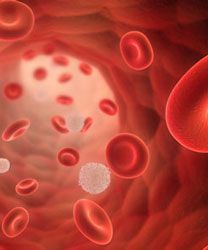Article
FDA Grants Priority Review to CPX-351 for AML
Author(s):
The FDA has accepted a new drug application from Jazz Pharmaceuticals, granting priority review to the company’s novel CPX-351 injection (Vyxeos) for acute myeloid leukemia.
Leukemia

The FDA has accepted a new drug application (NDA) from Jazz Pharmaceuticals, granting priority review to the company’s novel CPX-351 injection (Vyxeos) for acute myeloid leukemia (AML).
CPX-351 is an investigational nano-scale liposome co-formulation of cytarabine and daunorubicin at a synergistic 5:1 molar ratio.
Priority review status is designated for drugs that may offer major advances in treatment or provide a treatment where no adequate therapy exists. The designation accelerates the timing of the FDA review of the application compared with a standard review.
“We are pleased by the FDA’s acceptance of the NDA filing with priority review as this action emphasizes the need for new treatments for patients living with AML,” Jazz executive vice president and chief medical officer Karen Smith, MD, PhD, said in a statement. “We look forward to working with the FDA during this review process to obtain approval of Vyxeos as quickly as possible, as AML is the most common of all adult leukemias and AML patients have among the lowest survival rates.”
The NDA submission includes clinical data from 5 studies, including data from the pivotal phase III study comparing the formulation with cytarabine and daunorubicin (7+3) were presented at last year’s ASCO Annual Meeting. At the time, principal investigator Jeffrey E. Lancet, MD, senior member and chief of the Leukemia/Myelodysplasia Program at Moffitt Cancer Center, said the formulation, “should be considered standard first-line treatment for older patients with high-risk AML.”
Those phase III results showed that CPX-351 reduced the risk of death by 31% compared with 7+3 for older patients with high-risk, secondary AML. The formulation showed a median overall survival of 9.56 months (95% CI, 6.60-11.86) versus 5.95 months (95% CI, 4.99-7.75) with 7+3 (HR, 0.69; P = .005).
At 12 months, 41.5% of patients enrolled in the CPX-351 arm were alive versus 27.6% in the 7+3 arm. At 24 months, 31.1% of patients enrolled in the CPX-351 arm of the study remained alive compared with 12.3% with 7+3.
Median event-free survival was 2.53 months (95% CI, 2.07-4.99) with CPX-351 versus 1.31 months (1.08-1.64) with 7+3 (HR, 0.74; P = .021).
The randomized, controlled phase III trial included 309 patients across 39 sites throughout both the United States and Canada who were between the ages of 60 and 75. Patients enrolled in the study were split into either an age group consisting of patients between the ages of 60 to 69 or from 70 to 75.
Patients were randomly assigned to CPX-351 (n = 153) or 7+3 (n = 156). Patients in the CPX-351 arm were given a first induction of 100 u/m2 on days 1, 3, and 5. Patients in the control arm received 100 mg/m2 of cytarabine daily for 7 days, followed by 60 mg/m2 of daunorubicin on days 1, 2, and 3.
Second induction for patients enrolled in the CPX-351 arm was 100 u/m2 on days 1 and 3, while patients receiving conventional cytarabine and daunorubicin were given 100 mg/m2 of daily cytarabine for 5 days with 60 mg/m2 of daunorubicin on days 1 and 2.
Induction response rates (complete remission [CR] plus CR with incomplete hematologic recovery) were 47.7% for CPX-351 versus 33.3% for 7+3, yielding a relative benefit of 43.2% with the investigational treatment (P = .016). For CR alone, the rates were 37.3% and 25.6%, between CPX-351 and 7+3, respectively (P = .04).
The rates of grade 3 to 5 nonhematologic adverse events (AEs) were similar between the 2 arms. Common grade 3 to 5 AEs occurring in the 2 arms included febrile neutropenia (68% with CPX-351 vs 71% with 7+3), pneumonia (20% vs 15%), hypoxia (13% vs 15%), sepsis (9% vs 7%), hypertension (10% vs 5%), respiratory failure (7% each), fatigue (7% vs 6%), bacteremia (10% vs 2%), and ejection fraction decreased (5% each).
Based on these data, the FDA previously granted CPX-351 a breakthrough therapy designation as a treatment for patients with therapy-related acute myeloid leukemia (t-AML) or AML with myelodysplasia-related changes (AML-MRC).
The FDA granted CPX-351 fast track status for the treatment of elderly patients with secondary AML in January 2015. That decision was based on results from a pair of phase II studies in which CPX-351 showed promising results for patients with newly diagnosed and relapsed AML.
Lancet JE, Uy GL, Cortes JE, et al. Final results of a phase III randomized trial of CPX-351 versus 7+3 in older patients with newly diagnosed high risk (secondary) AML. J Clin Oncol. 34, 2016 (suppl; abstr 7000).






%20(2)%201-Recovered-Recovered-Recovered-Recovered-Recovered.jpg?fit=crop&auto=format)

%20(2)%201-Recovered-Recovered-Recovered-Recovered-Recovered.jpg?fit=crop&auto=format)
%20(2)%201-Recovered-Recovered-Recovered-Recovered-Recovered.jpg?fit=crop&auto=format)